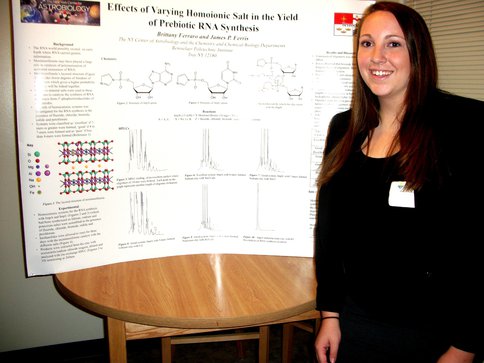2011 Annual Science Report
 Rensselaer Polytechnic Institute
Reporting | SEP 2010 – AUG 2011
Rensselaer Polytechnic Institute
Reporting | SEP 2010 – AUG 2011
EPO Activity: Undergraduate Research
Project Progress
Astrobiology research projects for a total of 17 undergraduates were carried out under the mentorship of NAI faculty during the reporting period. A major highlight was the award of first prize in the poster competition at the 2011 Annual RPI Undergraduate Research Symposium to Brittany Ferraro for her work on prebiotic RNA synthesis (see below). We were also particularly pleased to host Shaniqua Johnson from Cornell University in summer 2011 through the STEM Fellowship for Summer Research at Rensselaer program for women and minorities. The contributions of all undergraduates are summarized below, in order of the projects they were associated with (see also separate sections).
Project 1: Interstellar Origins of Preplanetary Matter (3 students).
Joseph Spizuco completed a project he began last year to investigate stellar populations in dense molecular clouds, using the 2MASS and WISE databases to develop a catalog of suitable targets for future spectroscopic observation. Cale Kochenour analyzed spectroscopic data from NASA’s Spitzer Space Telescope, and Steven Lentine worked on analysis of spectroscopic data from NASA’s ground-based Infrared Telescope Facility (IRTF): the merged Spitzer and IRTF data provides coverage of absorption features in different constituents of interstellar and circumstellar dust and ices, and results enable us to compare the chemical and thermal evolution of ices in the environments of young stellar objects of different luminosity and mass. Both Lentine and Kochenour will have journal articles published by the time they graduate in 2012/13.
Project 2: Processing of Precometary Ices in the Early Solar System (3 students).
Allycia Gariepy worked on numerical methods for simulating multifluid, magneto-hydrodynamic shock waves. Aaron Smith conducted numerical simulations of transiting planets in eccentric orbits. Nick Senno carried out molecular dynamics simulations to study the possible alignment of chiral molecules in supersonic flows.
Project 6: The Environment of the Early Earth (2 students).
Sebastian Mergelsberg worked on the incorporation of C in quartz and C and S in apatite, with the goal of evaluating the potential of these minerals to preserve biosignatures and/or samples of Earth’s early atmosphere. Both C and S are incorporated into apatite at 600-800 deg C, and their diffusivities are sufficiently low to allow preservation of isotope ratios of these elements in apatite over geologic time. Sebastian was also successful in showing that C diffuses into quartz as CO molecules. Egidio Tentori participated in an experimental study aimed at characterizing the uptake of aluminum in quartz, which is a potential indicator of pressure-temperature conditions, H2O activity and acidity of the crystallization environment (the ultimate aim of this study is to apply the results to quartz grains in the Hadean zircon-bearing Jack Hills conglomerate). Egidio obtained preliminary data on aluminum diffusion in the presence of Li, Na and K, elements with which Al diffusion is likely coupled.
Project 7: Prebiotic Chemical Catalysis on Early Earth and Mars (6 students).
Brittany Ferraro investigated the effects of varying homoionic clays in montmorillonite catalyzed RNA synthesis. Her research suggests a selective influence of salts in the oligomerization reactions attributed to hydrophilic and hydrophobic interactions in prebiotic RNA synthesis. Brittany participated in the 2nd Annual Undergraduate Research Symposium of RPI on April 5, 2011, where she received first prize for the poster presentation out of 47 participants with posters. She was also invited to be a guest speaker at the Eastern New York ACS Undergraduate Research Symposium on April 20, 2011.
Brittany Ferraro with her poster on the “Effect of varying homoionic salt in the yield of prebiotic RNA synthesis”, which won first prize (out of 47 entries) in the poster competition at the 2011 Annual RPI Undergraduate Research Symposium.
Anna Sheridan investigated the “salting in” and “salting out” of nucleotides in aqueous solutions: her objective is to determine the effect of monovalent, divalent and trivalent metal ions on the yields of RNA oligomers. Jason Szelog processed clay minerals obtained worldwide for chemical analysis and testing of catalytic activity in RNA synthesis. Edward Kurt investigated the interaction of activated mononucleotides on the catalytic surface of montmorillonite by solid state NMR. Alex Meola and Matthew Moellman worked on abiotic polymerization of activated RNA and activated nucleotides with alternative sugars on montmorillonate clay and MALDI-Mass spectrometric detection of the products.
Project 9: Microenvironmental Influences on Prebiotic Synthesis (3 students).
Shaniqua Johnson from Cornell University participated in this project during summer 2011 through the STEM Fellowship for Summer Research at Rensselaer program for women and minorities. Shaniqua’s main focus was on the effects of amino acids on abiotic RNA polymerization. She performed RNA polymerization reactions using catalytic clays that had been titrated with either alanine or tryptophan. HPLC and MALDI-MS were used to analyze the reaction products. Shaniqua also prepared and visually characterized gels formed by mixtures of GMP with guanosine. We are interested in the effects of these gels on abiotic RNA polymerization. RPI undergraduate John Grossman performed abiotic RNA polymerization reactions on catalytic clays and prepared various gel phases formed by GMP with other ribonucleotides guanosine gels for investigation of their effects on the polymerization reaction. RPI undergraduate Elizabeth Moriarty collected circular dichroism (CD) spectra of the gels for structural characterization and performed thermal melts to investigate their thermal stability and reversibility.
